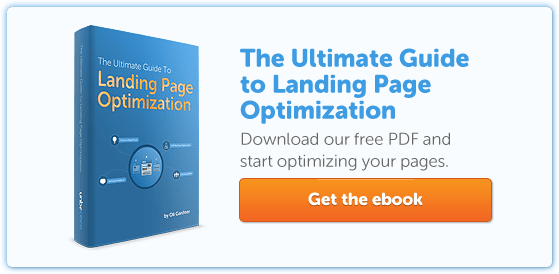
Landing page optimization isn’t just about tactics.
Sure, there are many tactical ways to improve your conversion rate: test your CTA button copy, test a shorter page, change this picture, make that button bigger…
But if you don’t understand the more strategic side of things – the psychological wizardry that goes into a winning landing page – then your optimization efforts are just a shot in the dark.
Here are three psychological principles that will help you make your offer more persuasive – and turn your landing page into a conversion gold mine.
1. The psychology of pleasure: What will make prospects feel happy?
Epicurus was one of the first pleasure psychologists.
From his teaching, experimentation and deep thinking, Epicurus created a theory of happiness — a theory of human nature as a whole. And the bottom line is this:
People make choices based on what will make them happy.
The pursuit of happiness is every individual’s greatest desire, according to the philosopher. No one is going to intentionally choose pain unless they think it will somehow make them happy.
How do you apply the psychology of pleasure to landing pages?
When it comes to creating a high-converting landing page, there are many things you can do to align yourself with your prospects’ unbridled search for happiness:
- People think of themselves first. Focus on them. Use the word “you” a lot. Refer to their wellbeing, the choice they’re making and how it’ll make them feel.
- People feel happy when they have a clear sense of understanding about the product or service. Show pictures of the product in context, or at the very least, clearly describe it.
- People feel happy when they know that other people are happy (non-enemies, of course). Feature testimonials of happy, smiling customers.
- People feel happy when they are brought to a satisfying and logical conclusion. Use a longform landing page with a clear start, cognitive flow, conclusion and call to action.
- People feel happy when they see visuals they like. Incorporate visuals that humans have been scientifically proven to appreciate:
- People feel happy when they read happy words. Write copy that is upbeat, delightful, optimistic and nonthreatening.
The psychology of pleasure in action
The landing page below by KISSmetrics packs many of these psychological insights into one powerful, pleasing page.
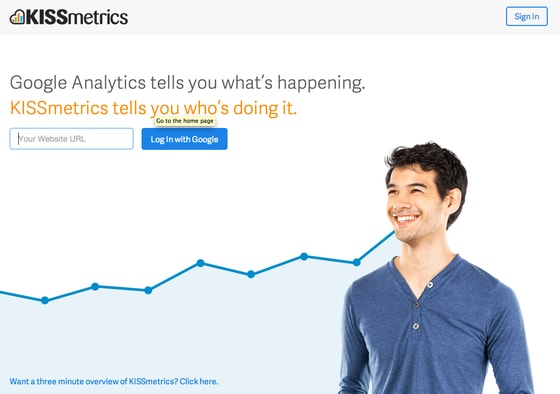
Notice their use of the word “you” (x2). Notice the clarity of the offer. Notice the smiling face. Notice how KISSmetrics does it all with absolute simplicity, obvious cognitive flow and an abundance of whitespace.
Or how about this landing page by Fast Track?

See what’s going on here? They’ve got a picture of a smiling dude. The headline and supporting copy are highly optimistic. An anxious seller receives the assurance that this company will sell their home – fast. Just look at that upbeat testimonial!

Don’t forget to test everything
Understanding these principles will only take you so far; you still need to test your assumptions. As CrazyEgg writer Scott Martin explains in this article about happiness:
It’s impossible to find significant testing data when it comes to stressing happiness over other approaches.
What he’s getting at is that every audience finds pleasure in something different.
So you’ve got to test.
2. The psychology of pain: What do they want to avoid?
Epicurus, the philosopher who wrote about pleasure, once penned this:
The magnitude of pleasure reaches its limit in the removal of all pain.
Whether mental or physical, we’re wired to avoid pain. It sounds relatively simple, but understanding this can come in handy when setting up your next campaign.
How can you apply the psychology of pain to landing pages?
When it comes to apply the psychology of pain to your landing page, it’s about avoidance. What do your prospects most want to avoid?
If you can cause people to remember or feel the pain of something, then they will respond by seeking to avoid it — and, assuming you’ve done things correctly, that means they’ll convert.
A quick example should help clarify this:
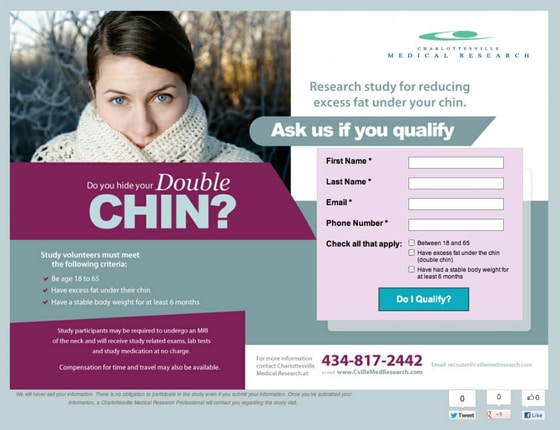
Charlottesville Medical Research’s landing page is effective because:
- It pinpoints where prospects hurt. The headline, “Do you hide your double chin?” exposes the feeling of shame that prospects may feel. Both the supporting copy and imagery (a woman trying to hide her chin from view) evoke feelings of embarrassment.
- If offers the solution. The headline above the opt-in form promises a potential solution, in the form of a research study for reducing excess fat under the chin.
Similarly, check out how Bills.com employs the psychology of pain on their landing page:
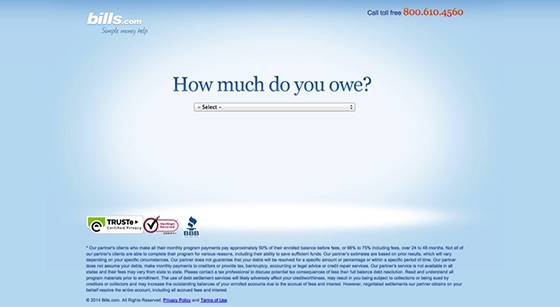
Many people feel a high degree of anxiety due to finances. Bills.com doesn’t shy away from poking that and digging around a little bit.
They want you to feel the pain of your debt so they can help erase it.
Starting the customer relationship off by making them think of pain and draws on individual incentives to alleviate that pain. And that results in a desire to find a solution – making prospects likely to convert.
3. The psychology of spending: How much do they want to spend?
When it comes to spending there are two kinds of people in the world: spenders and savers.
These tendencies seem to be hardwired into our personality, as described by Rick, Cryder and Loewenstein in their paper, “Tightwads and Spendthrifts.” (Great research by the way. I recommend it.)
The paper explains that every customer that buys from you will land on your page knowing a range of approximately how much they want to spend.
You can gently influence that price range with techniques such as framing, but the way they’ll react to the price of your offer is largely pre-determined and hardwired in their brains.
How can you apply the psychology of spending to landing pages?
Leveraging the psychology of spending on your landing page is all about aligning yourself with your prospects’ expectations:
- Find your prospects’ ideal price point and show them that number.
If you understand the ideal price point for your prospects, why swim upstream? Go with the flow and tell them what they want to hear. - Show prospects how much they’ll save by purchasing your product.
Frugal people are driven by loss aversion. For penny-pinchers, the motivation not to lose something is greater than the desire to gain something; they want to see dollars saved. Similarly, you can experiment with telling penny-pinchers how much money they will lose if they don’t buy your product.
Check out this example from Geico:
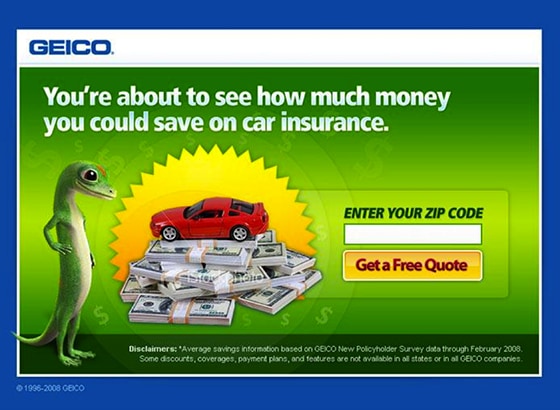
Nailed it. They consistently focus on how much you’ll save if you switch to their insurance.
Psychology gives you the key to higher-converting landing pages
Peek under the hood of this wonderful thing called the human brain and you’ll find that there’s power in psychology.
Just remember that these principles aren’t silver bullets for conversion. Understanding them simply allows us to formulate smarter A/B testing hypotheses. You still need to test.
Our minds work in certain ways and operate on certain principles. When we grasp those principles, we are holding the key to unlocking torrents of conversions.
Ready to create landing pages that really resonate with prospects?
More to the point, are you ready to create pages that convert?
![]()
